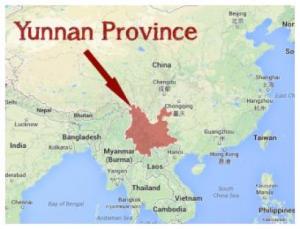Bruce Robertson, Assistant Professor of Biology, Bard College
In July, 2016, I traveled to Yunnan Province, China with my colleague Monique Segarra with the goal of better understanding the socio-economic and political environment shaping the conservation of ecosystems and natural resources in the region. Our central goal was to use interviews to generate an understanding of issues and to identify important and relevant case-studies in conservation that we could use in our respective courses (e.g. for me: Conservation Biology in Practice, a seminar in biology). We chose Yunnan because it represents a nexus of environmental decision-making that seem relevant to the country as a whole, but also because the region has become a focus of national and international attention due to the way in which its unique national resources are being developed for tourism. More specifically, the region represents one of the least-developed and so most ecologically intact and biodiverse regions of China. Because of its scenic beauty, the upland regions have been identified by the Beijing government as a valuable resource for the development of a tourist economy and this has led to an effort to create a first national park system while incorporating local people into those economies in ways that maintain biodiversity and ecosystem function. Because it helps direct monsoon rainfall into two the most important river systems in China, the region represents a major source of clean water for the country and so generates a legitimate concern for the integrity of its watersheds. From the lowland tropical forests in the south near the borders of Laos and Burma, terrain elevates the region to upwards of 12,000 feet in the Northwest where Yunnan meets Tibet and pine trees give way to alpine tundra.
To explore the environmental, cultural and economic impacts of the expansion of natural protected areas and national parks in the province, we used available connections to set up interviews with a diversity of NGO’s, natural scientists, and conservation practitioners beginning in the southern provincial capital of Kunming, moving northward and upward in elevation to the region surrounding the city of Li Jiang, and finally to the scenic high-elevation region in the North recently renamed from Zhondian to ‘Shangri-La’ where pressure from Beijing to develop domestic tourism is highest.
Our first interviews were with scientists at the Yunnan University Institute of Botany and Geosciences and those from the Kunming Institute of Botany and the World Agroforestry Center. The former were a group of scientists with expertise in the natural history, ecology and evolution, and conservation of plant life in the region. They gave us with a presentation on the ecology, biomes, geology, cultural diversity and natural history of the region that provided us with a basic context for everything we were to view after. This incredibly generous group of scientists was especially notable for their efforts in working over the last decade to establish the first national park system in the China. Much has been written about the successes and failures resulting from the challenges to establish a park system which I won’t duplicate here. Such efforts inevitably involve the cooperation of a great diversity of stakeholders (e.g. natural resource managers, tourism developers, local people with natural resource-based economies, etc.) with different goals that must be resolved. However, this conversation was the first in which we began to realize that one important part of the challenge in China was the unique role and operation of the government.
First, the central government operates on a series of 5 year plans which tend to emphasize new themes and goals to be accomplished over that time. The 5 year plans signal shifts in policy intent of top leadership in the Chinese national government. These plans may establish no new laws, but they have the de facto effect of strengthening and weakening existing legislation, providing new interpretation of existing laws and perhaps guiding their application in ways they were previously not intended. Provincial governments are also expected to create their own 5 year plans, and so down to cities. One challenge in the ongoing development of national parks has been the changing emphasis of the Beijing government in the development of those resources for tourism. In particular, how they balance their priorities in economic development with resource conservation and the politically and culturally-delicate issue of integrating local people into the new economies generated by the creation of those parks.
There are currently 6 national parks in China, with a plan for the creation of 16 more. The first, Potatso National Park which we visited, was established in 2007 after nearly a decade of planning and work. That effort originally began with some major international partners including The Nature Conservancy. International interest in the conservation of biodiversity in the region was high, international money was flowing into the region targeting local organizations to support conservation efforts in conjunction with state actors. However, in 2008 the global economic crisis undermined TNC’s philanthropic base and along with the diplomatic difficulty of operating so near the Tibetan province, TNC left the region, leaving conservation planning and the development of parks almost entirely to domestic stakeholders. In general, the national park model has been very successful in attracting Chinese tourists and in infusing money into the local and provincial economies, but success having local people capture some portion of this economic windfall has been much more uneven.
Potatso National Park is a case study in one form of success. Visitors to the park see it through a combination of bus rides and hikes along boardwalks that keep almost all tourist activity to a very narrow section of the park, reducing the ecological footprint of visitors on fragile habitats (e.g. freshwater wetland) and species (e.g. Red Panda). Throughout the lowlands of the park, however, one will see grazing horses and yaks that belong to nomadic herders whose use of the area predates the park. Their activities have been integrated into the conservation and economic goals of the park and this role is advertised through informational placards, bus-ride narration and is even the central focus of one of the 5 bus stops one visits during the standard park tour. This success, however, is not well-duplicated in some other parks, for example, where it appears Beijing has variously directly or indirectly through its funding of targeted research, appears to have worked to exclude local people from the use of national parks, presumably because their presence can interfere with the scenic beauty of the park, which is the primary draw for tourists.
Outside of national parks in Yunnan, tourist dollars tend to be more often spent at handicraft stores, hotels and restaurants that are owned by Han Chinese and the indigenous Naxi and Tibetan people, for example, have had more difficulty in taking advantage of these substantial economic inputs. One reason is that while training locals in particular trades (e.g. cooking, handicraft work) can be effective, the crucial business and marketing skills necessary to run businesses are lacking. Providing necessary skills and resources for helping local people capitalize on the tourism money associated with National Parks or protected areas is also complicated by past interactions between locals and the national or central government, especially in the very large region of China outside of the borders of Tibet proper, but still occupied by those of Tibetan heritage. Once a large autonomous kingdom, Tibet was taken over in a military campaign by China in 1951. Resentment among the Tibetan people remains and plays a role in how they respond to support. For example, USAID funded some development projects in this region and requires their logo to be displayed at development sites where their money is being used. Provincial state workers, however, apparently also have a habit of tearing down these signs and in opposing these efforts. The reason is not because they oppose the goals of these efforts. Instead, it is because the provincial and central government puts significant amounts of money into similar projects, but rarely gets recognition from Tibetans because of the historical acrimony. As such, this resentment leads to frustration and similar resentment by state actors that their efforts to help are not recognized by the Tibetan community, and additional acrimony toward international organizations to whom the gratitude of Tibetans is more often directed.
Air, water and soil pollution are so extensive in China that the country is internationally recognized for its environmental degradation in these categories. Throughout the world, the most common sources of pollution are private businesses and industries. China is no exception, but the structure of its industrial sector and the uneven implementation of its environmental laws complicate the ability of communities or non-state actors to hold industry responsible for pollution. We met with an NGO that has been working for years in helping people who are victims of water and soil pollution. Several case studies were described to us in which privately owned companies were found to have knowingly poisoned rivers and lands used by local communities with dangerous heavy metals. Getting these cleaned up, and/or local people compensated, was not easy or always possible. Although China has a relatively thick set of environmental laws with specific mechanisms for fining polluting companies and forcing them to clean up the messes they created, incentivizing the provincial government to enforce is often problematic. This is in part because the jurisdiction within which industry is sited and the national government benefit from taxing industrial production. In some cases, a combination of political pressure through protests or the media is necessary to press local government agencies to enforce. Even then, the outcome of these situations are far from certain and seem to depend very heavily on the attitude of local governmental leaders about the issue itself.
Indeed, local people can be central to environmental conservation, but often need help in accomplishing their goals. When it comes to addressing and preventing pollution, help might come in the form of giving local citizens tools for understanding their rights as it pertains to providing input on environmental impact statements, opposing development, or forcing clean-ups. Because the economies of local people are often intimately tied to their natural resources, they are often the best stewards of those resources. Yunnan, for example, is the global center of edible mushroom diversity and the sustainable harvest of these mushrooms provides a huge input into household economies. Locals have evolved a number of different systems for managing these mushrooms via allotting territories to village members or even auctioning off territories as a part of a system that asks harvesters to reallocate a fraction of proceeds toward the village or the actual land-owners. Scientists have helped locals by helping them identify the more valuable mushrooms and using collaborative, citizen-based research to identify techniques of harvest that increase yields.
In other cases, local villages have actually opposed attempts to log forests and build roads, even when the coalitions of local and central government employees and businessmen opposed their efforts. In some cases, and when success depended on outside expertise (often legal), villages have worked with NGO’s to fight development and pollution, often successfully, which one might find surprising in a country where the central government exerts so much political power and control over information.
It must be noted the NGO’s in China operate differently from those in the West, for example. This is, in part, because many of the environmental problems in China are caused by actions that are directly or indirectly sanctioned directly by national lawls or the state-sanctioned interpretation of those locals at the regional, provincial, or local levels. Attempts to fight environmental injustice or may directly oppose not just the interpretation of laws, but the word of those laws which may or may not currently be emphasized by the current 5-year plan. As a consequence NGO’s have specific operational paradigms that differ from those in the west. First, there appear to be relatively few NGOs in areas that work in areas of environmental conservation where conflict with the government can be more likely to lead to their leaders or employees ending up in jail. Freedom of speech is not a right of citizens in China and because the application of laws and their interpretation can be used by governments to punish those that opposed the sentiments of the state, this hinders production of a culture of environmental advocacy. The threat of jail parallels the dangers of environmental activism in other parts of the world, notably Central and South America, where private enterprise is more divorced from the state, and where there is an ongoing crisis of corporate entities assassinating environmental activists who oppose development, protest pollution or gain heavy influence in politics. A second notable characteristic of Chinese NGO’s is that they appear to have carefully thought-out strategies for advocating their goals and accomplishments (e.g. via meetings, websites) that don’t necessarily reflect the sum total of their actions and successes. In other parts of the world, where advertising your efficacy and efficiency in accomplishing important goals leads to increased attention, prestige and success in obtaining funding, these same activities may lead Chinese NGO’s to gain attention from government officials that don’t appreciate their activities and so may more actively oppose it or worse.
The observations I’ve made here are based upon my observations in only a single province of China and may not characterize the province or the country as a whole, though I have often generalized in this way above where it seemed appropriate or logically supported. East Asian countries are commonly characterized by their complex languages with sometimes large and complicated alphabets, and are considered the most difficult languages for English speakers to learn. One consequence is a strong language barrier that currently seems best breached through the use of English-speaking Chinese, often hired guides or translators. Collectively, we found the Han, Naxi, and Tibetan people we met to be wonderfully warm and generous people that appeared to be very open in sharing information with us, even when it might be inconvenient or possibly compromising to them. Even so, the connections and relationships we formed were short-term and our experience limited and so I believe it is important to consider that the case studies and information we learned are undoubtedly incomplete in a number of ways and reflective of certain points of view and through the ongoing window of information-loss associated with the passage of time.
Natural resource conservation (e.g. the formation of National Parks) in China seems to face similar challenges and outcomes in other parts of the world. These include, cultural differences, the difficulty of resolving interests of multiple stakeholders, integrating resource conservation and sustainability into tourism, and integrating local people into tourist economies and the conservation of local resources. However, China faces unique opportunities and challenges. It’s large and growing population has the ability to put heavy pressure on natural resources. The ability of local people to address industry-driven environmental problems is complicated by the government ownership of much of that sector. And it is Beijing’s ability to redirect and change policy that has at once been an incredible strength and a terrible hindrance in protecting and restoring environmental resources in China. This powerful top-down government structure driven by a political party with a very singular voice and legally tied to industry allows China to rapidly change direction, alter existing laws, improve compliance and to link multiple aspects of its government and economic machine to accomplish tasks. Currently, China is investing heavily in science, environmental production and in mitigating and repairing environmental damage that is has done in ways that would be impossible in their speed an efficacy in the USA and Europe. The Chinese government should be congratulated for the degree of investment they have made in environmental conservation in China over the last decade or two, and in the creative strategies they have taken in doing so. Yet, the same traits that have allowed China to rapidly change direction and make those investments can also make it difficult for China to tailor its approaches in ways that help people facing very local environmental problems. Ongoing challenges remain for China and it will take time for the culture of perception about the value of the environment and the importance of sustainability to become more culturally engrained throughout the country. Yet, there are many reasons to be optimistic that Beijing will continue to evolve in ways that allow it to work with local people and governments toward a future centered on a healthy environment.
Collectively, I found this trip valuable for a number of reasons. First, it illustrated for me the tremendous importance of understanding how laws interface with socio-economic realities and politics in shaping conservation outcomes. The case-studies we learned of provided a real diversity of ways in which conservation successes and failures were typical or atypical of mechanisms that occur elsewhere in the world. Second, I have really learned a great deal of the value of case studies in understanding how conservation successes are multidisciplinary efforts in navigation. I was also able to attend the LIASE-sponsored trip to South Korea last year and so my perspectives here are also profoundly shaped by my experience there. I feel for the first time that my eyes have been opened to a much broader spectrum of the factors that shape conservation and environmental policy and practice and that I am much better equipped to pass these lessons on to my students in a richer, more personal and relevant way. Finally, I have discovered some new interests in unfamiliar areas. Dr. Segarra and I have started conversations with Chinese academics about potential research collaborations in comparative environmental policy. Noticing that traditional belief systems have a diversity of very positive, and occasionally negative impacts on local ecosystems, I’ve developed an academic interest in learning more about the interface of religion and conservation ecology that I hope to develop into academic research in the future.




